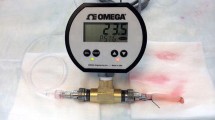Abstract
Purpose of this paper is to investigate the hemostatic capabilities of a novel vascular sealing device consisting of a balloon catheter and procoagulant.
Vascular sheaths were placed percutaneously in the femoral arteries of dogs. The sealing device was evaluated using the balloon catheter alone in 6 femoral arteries and with the addition of a procoagulant in 21 femoral arteries.
The balloon catheter alone was successfully deployed in 6 of 6 femoral arteries achieving immediate hemostasis. In a second study in which the procoagulant was delivered following balloon placement, the sealing device was successfully deployed and hemostasis was achieved in 20 of 21 attempts (95%) despite removal of the balloon catheter. In a subset of fully anticoagulated animals, hemostasis was achieved in the sealing device-treated arteries at 6.5±3.4 minutes but in none of the controls (p<0.001).
This novel vascular sealing device successfully achieves rapid hemostasis in normal and anticoagulated dogs following percutaneous vascular procedures.
Zusammenfassung
Ziel dieser Arbeit ist es, die hämostatischen Eigenschaften des neuen arteriellen Verschlußsystems, welches im wesentlichen aus einem Ballonkatheter und einer prokoagulatorischen Mischung besteht, zusammenfassend darzustellen.
Das Verschlußsystem wurde experimentell an Hunden geprüft: Nach Einführen einer Schleuse in die Arteria femoralis wurde der Ballonkatheter des Verschlußsystems in sechs Femoralarterien und mit zusätzlicher Verwendung der prokoagulatorischen Mischung in 21 Femoralarterien untersucht.
Der Ballonkatheter wurde in allen sechs Femoralarterien erfolgreich eingesetzt, so daß bei Aufdehnung des Ballons die Hämostase sofort eintrat. In einer zweiten Studie mit zusätzlicher Gabe der prokoagulatorischen Mischung konnte eine erfolgreiche Hämostase bei 20 der 21 Anwendungen (95%) erzielt werden, obwohl der Ballonkatheter entfernt wurde. In einer Untersuchungsreihe an voll antikoagulierten Tieren konnte eine Hämostase mit dem neuen Verschlußsystem nach 6,5±3,4 Minuten erzielt werden, jedoch nicht bei den Kontrolltieren (p<0,01).
Somit führt dieses neue Verschlußsystem bei normalen und antikoagulierten Hunden nach perkutanen vaskulären Eingriffen zu einer raschen Hämostase.
Similar content being viewed by others
References
Abbott WM, Austen WG. The effectiveness and mechanism of collagen-induced topical hemostasis. Surgery 1975;78:723–9.
Aker UT, Kensey KR, Heuser RR, et al. Immediate arterial hemostasis after cardiac catheterization: Initial experience with a new puncture closure device. Cathet Cardiovasc Diagn 1994;31:228–32.
Bartorelli AL, Sganzerla P, Fabbiocchi F, et al. Prompt and safe femoral hemostasis with a collagen device after intracoronary implantation of Palmaz Schatz stents. Am Heart J 1995;130:26–32.
Carere RG, Webb JG, Ahmed T, et al. Initial experience using prostar™: A new device for percutaneous suture-mediated closure of arterial puncture sites. Cathet Cardiovasc Diagn 1996;37:367–72.
de Swart H, Dijkman L, Hofstra L, et al. A new hemostatic puncture closure device for the immediate sealing of arterial puncture sites. Am J Cardiol 1993;72:445–9.
Dick RJ, Popma JJ, Muller DW, et al. In hospital costs associated with new percutaneous coronary devices. Am J Cardiol 1991;68:879–85.
Fischman DL, Leon MB, Baim DS, et al. A randomized comparison of coronary stent placement and balloon angioplasty in the treatment of coronary artery disease. N Engl J Med 1994;331:496–501.
Krause PB, Klein LW. Utility of a percutaneous collagen hemostasis device: To plug or not to plug? J Am Coll Cardiol 1993;22:1280–2.
Kussmaul WG, Buchbinder M, Whitlow PL, et al. Rapid arterial hemostasis and decreased access site complications after cardiac catheterization and angioplasty: Results of a randomized trial of a novel hemostatic device. J Am Coll Cardiol 1995;25:1685–92.
Muller DW, Shamir KJ, Ellis SG, et al. Peripheral vascular complications after conventional and complex percutaneous coronary interventional procedures. Am J Cardiol 1992;69:63–8.
Oweida SW, Roubin GS, Smith RB, et al. Post-catheterization vascular complications associated with percutaneous transluminal coronary angioplasty. J Vasc Surg 1990;12:310–5.
Popma JJ, Satler LF, Pichard AD, et al. Vascular complications after balloon and new device angioplasty. Circulation 1993;88:1569–78.
Sanborn TA, Gibbs HH, Brinker JA, et al. A multicenter randomized trial comparing a percutaneous collagen hemostasis device with conventional manual compression after diagnostic angiography and angioplasty. J Am Coll Cardiol 1993;22:1273–9.
Satler LF, Mintz G. Percutaneous hemostatic closure systems: Is the cost worth the price? Cathet Cardiovasc Diagn 1996;37:373–4.
Schrader R, Steinbacher S, Burger W, et al. Collagen application for sealing of arterial puncture sites in comparison to pressure dressing: A randomized trial. Cathet Cardiovasc Diagn 1992;27:298–302.
Seldinger SI. Catheter replacement of the needle in percutaneous arteriography a new technique. Acta Radiol 1953;39:368.
Silber S, Hemostasis success rates and local complications with collagen after femoral access for cardiac catheterization: Analysis of 6007 published patients. Am Heart J 1998;135:152–6.
Silber S. Rapid hemostasis of arterial puncture sites with collagen in patients undergoing diagnostic and interventional cardiac catheterization. Clin Cardiol 1997;20:981–92.
The EPIC Investigators. Use of a monoclonal antibody directed against the platelet glycoprotein IIb/IIIa receptor in high-risk coronary angioplasty. N Engl J Med 1994;330:956–61.
Vainer J, Meier B. has the time come for the plug? Cathet Cardiovasc Diagn 1996;37:366.
Vaughan DE, Schafer AI, Loscalzo J. Normal mechanisms of hemostasis and fibrinolysis. In: Loscalzo J, Creager MA, Dzau VJ, eds. Vascular medicine. Boston: Little, Brown 1992:243–4.
Waksman R, King III SB, Douglas JS, et al. Predictors of groin complications after balloon and new-device coronary intervention. Am J Cardiol 1995;75:886–9.
Wyman RM, Safian RD, Portway V, et al. Current complications of diagnostic and therapeutic cardiac catheterization. J Am Coll Cardiol 1988;12:1400–6.
Author information
Authors and Affiliations
Corresponding author
Rights and permissions
About this article
Cite this article
Gershony, G., Jensen, T. The duett™ closure device: Concept and experimental results. Herz 24, 614–619 (1999). https://doi.org/10.1007/BF03044485
Issue Date:
DOI: https://doi.org/10.1007/BF03044485




